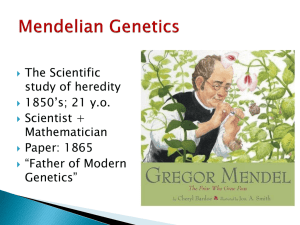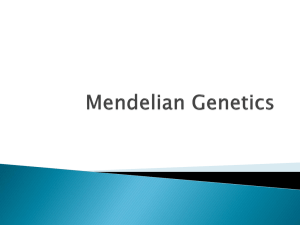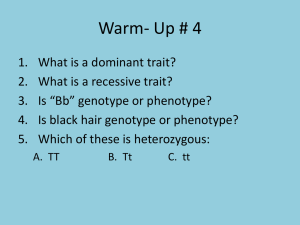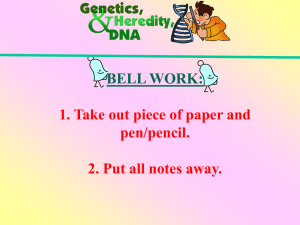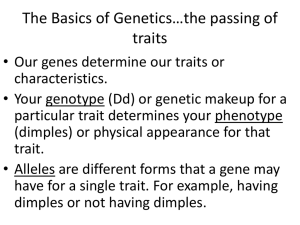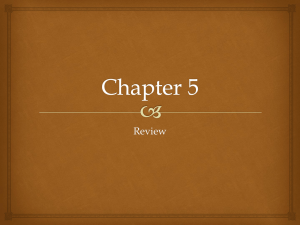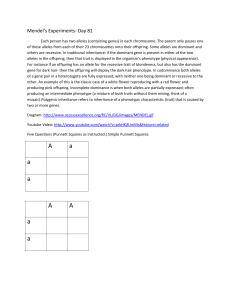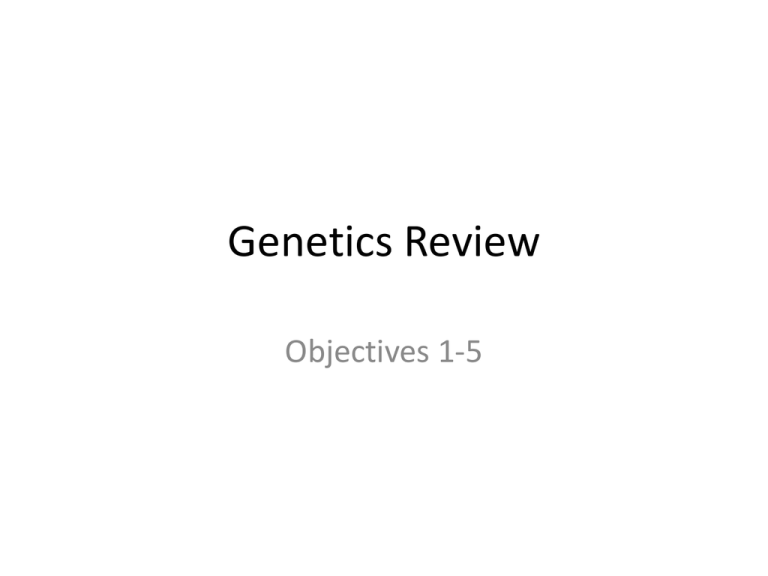
Genetics Review
Objectives 1-5
Objective 1 - Distinguish between the following pairs of terms:
dominant and recessive; heterozygous and homozygous;
genotype and phenotype.
• Define genotype
• Define phenotype
Answer
•
•
Genotype –Actual physical DNA
make up of an organism. 2) The
genetic constitution of an
individual, including alleles carried
for a particular trait. Compare to
phenotype. (i.e. A pea with a round
phenotype could have a genotype
of RR or Rr).
Phenotype - Physical and
behavioral characteristics of an
organism. 2) An individual's
observable form. Compare to
genotype. (i.e. A pea with a round
phenotype could have a genotype
of RR or Rr).
• Define homozygous –
• Define heterozygous -
Answer
• Homozygous - Having
identical alleles for a trait.
2) Carrying two copies of
the same allele. Compare to
heterozygous. (i.e. A
homozygous plant could
have the genotype RR or rr).
• Heterozygous - Having
different alleles for a trait.
2) Carrying two different
alleles. Compare to
homozygous. (i.e. The
heterozygous plant has the
genotype Rr).
A test cross is used to determine if the genotype
of a plant displaying the dominant phenotype is
homozygous or heterozygous.
You always cross your unknown with a pure
recessive (displays the recessive trait)
If the unknown is homozygous dominant, all of
the offspring of the test cross have the
__________ phenotype.
If the unknown is heterozygous, half of the
offspring will have the __________ phenotype.
Answer
• dominant, recessive
• Dominant is expressed if it is present, AA or Aa
• Recessive is expressed only if the dominant is
not present , aa
Objective 2 - Use a Punnett square to predict the results of a
monohybrid and a dihybrid cross and state the phenotypic and
genotypic ratios of the F2 generation.
1. Monohybrid Cross: look at one trait
In pea plants, spherical seeds (S) are
dominant to dented seeds (s). In a genetic
cross of two plants that are heterozygous for
the seed shape trait, what fraction of the
offspring should have spherical seeds?
¾
Answer
One fourth of the
offspring will be
homozygous dominant
(SS), one half will be
heterozygous (Ss), and
one fourth will be
homozygous recessive
(ss).
Question 2
2. Monohybrid Cross
A phenotypic ratio of 3:1 in the offspring of a
mating of two organisms heterozygous for a
single trait is expected. How does this occur?
During what process does this occur?
Answer
• The alleles segregate during meiosis. Mendel
first proposed that alleles segregate from one
another during the formation of gametes.
Question 3
Dihybrid Cross: look at two traits
True-breeding pea plants with spherical seeds
were crossed with true-breeding plants with
dented seeds. (Spherical seeds are the dominant
characteristic.) Mendel collected the seeds from
this cross, grew F1-generation plants, let them
self-pollinate to form a second generation, and
analyzed the seeds of the resulting F2 generation.
The results that he obtained, and that you would
predict for this experiment are: (give both the F1
and F2 generations)
True Breeding or pure = homozygous
Hybrid = heterozygous
All the F1 and 3/4 of
the F2 generation
seeds were spherical.
All of the F1 plants
were true hybrids
with a phenotype of
Ss. The recessive trait
reappears in the F2
generation.
Question 4
• A genetic cross between two F1-hybrid pea
plants for spherical seeds will yield what
percent spherical-seeded plants in the F2
generation? (Recall, spherical-shaped seeds
are dominant over dented seeds.)
Answer
• 75%
Dihybrid cross
• A pea plant is heterozygous for both seed
shape and seed color. S is the allele for the
dominant, spherical shape characteristic; s is
the allele for the recessive, dented shape
characteristic. Y is the allele for the dominant,
yellow color characteristic; y is the allele for
the recessive, green color characteristic. What
will be the distribution of these two alleles in
this plant's gametes?
Answer
25% of gametes are SY; 25% of
gametes are Sy;
25% of gametes are sY; 25% of
gametes are sy.
Alleles of different genes are
assorted independently of
each other during the
formation of gametes.
• Which of the following genetic crosses would
be predicted to give a phenotypic ratio of
9:3:3:1?
A. SSYY x ssyy
B. SsYY x SSYy
C. SsYy x SsYy
D. SSyy x ssYY
E. ssYY x ssyy
Answer
C. SsYy x SsYy
• What is the expected phenotypic ratio of the
progeny of a SsYy x ssyy test cross?
Answer
SsYy, ssYy, Ssyy, ssyy are predicted
to occur in a ratio of 1:1:1:1.
• In a dihybrid cross, AaBb x AaBb, what fraction
of the offspring will be homozygous for both
recessive traits?
Answer
• 1/4 of the gametes of
each parent will be ab.
The fraction of the
offspring homozygous
for both recessive traits
will be 1/4 times 1/4, or
1/16.
Objective 3 - Explain how the phenotypic expression of the
heterozygote is affected by complete dominance, incomplete
dominance, and co-dominance.
• With incomplete dominance, a cross between
organisms with two different phenotypes
produces offspring with an intermediate
phenotype (3rd phenotype) that is a blending
of the parental traits.
A cross between a blue blahblah bird & a white
blahblah bird produces offspring that are silver. The
color of blahblah birds is determined by just two
alleles.
a) What are the genotypes of the parent blahblah
birds in the original cross?
b) What is/are the genotype(s) of the silver
offspring?
c) What would be the phenotypic ratios of offspring
produced by two silver blahblah birds?
Answer
a) What are the genotypes of the parent
blahblah birds in the original cross?
Since there are only 2 alleles & three
phenotypes (blue, white, & silver), we
must be dealing with incomplete
dominance. So the blue parent is
homozygous blue (BB) & the white parent
is homozygous white (bb).
b) What is/are the genotype(s) of the
silver offspring?
The silver offspring are hybrids (Bb), one
blue allele & one white allele, neither one
dominating the other. Instead, we get a
blending of blue & white, i.e. silver.
c) What would be the phenotypic ratios of
offspring produced by two silver blahblah
birds?
silver x silver = Bb x Bb.
25% (1/4) of the offspring are
homozygous white (bb), 25% (1/4) are
homozygous blue (BB), & 50% (2/4) are
hybrid & therefore have the silver
phenotype.
With codominance, a cross between organisms with two different
phenotypes produces offspring with a third phenotype in which both
of the parental traits appear together.
1. Predict the phenotypic ratios of offspring when a
homozygous white cow is crossed with a roan bull. (Roan
is a result of brown and white hairs being closely located
to give the appearance of reddish)
2. What should the genotypes & phenotypes for parent
cattle be if a farmer wanted only cattle with brown fur?
3. A cross between a black cat & a tan cat produces a
tabby pattern (black & tan fur together).
a) What pattern of inheritence does this illustrate?
b) What percent of kittens would have tan fur if a tabby
cat is crossed with a black cat?
Answer
1. Predict the phenotypic ratios of offspring when a homozygous white cow is crossed with a roan bull.
Step #1 --- recognize that "roan" is a codominance trait. Homozygous white = WW, & roan = RW (a hybrid cow).
So our cross is WW x RW & the punnett square should look something like what you see here.
The results:
2/4 offspring (50%) will be roan (RW), & 50% will be white (WW).
2. What should the genotypes & phenotypes for parent cattle be if a farmer wanted only cattle with brown fur?
Well, the only way to have brown fur is to be homozygous brown (RR). In order to get that genotype in all the
offspring both parents must be "RR". A parent with one or more "W" alleles will cause the inheritence of roan fur in
some offspring.
Only RR x RR gives you 100% RR.
RR x RW would produce 50% roan, 50% brown,
RW x RW produces 25% brown, 50% roan & 25% white,
WW x RW would produce 50% roan, 50% white,
& WW x RR would produce 100% roan (RW).
3. A cross between a black cat & a tan cat produces a tabby pattern (black & tan fur together).
a) What pattern of inheritence does this illustrate?
Codominance, two phenotypes together at the same time.
b) What percent of kittens would have tan fur if a tabby cat is crossed with a black cat?
Tabby cats are the hybrids (because they have both colors) & a black cat must be homozygous black.
So the cross for this problem is BB (black) x BT (tabby
The results show that 50% of the offspring will be BB (black) & 50% will be tabby (BT). So to answer the question, 0% of
the kittens will be tan.
Blood Type Problem
• In humans the blood groups are produced by
various combinations of three alleles IA, IB, and
i. Blood type A is caused by either IA IA or IA i;
type B by IB IB or IB i; type AB by IA IB; and type
O by i i. Suppose a child is of blood type A and
the mother is of type 0. What type or types
may the father belong to?
Answer
• Since the mother can only provide alleles for
O type blood (i), the father must provide the
allele for blood type A (IA). Three genotypes
can provide the IA allele: IA IA (blood type A), IA i
(blood type A), or IA IB (blood type AB). So the
father must be either blood type A or blood
type AB. The child (with blood type A) must be
heterozygous, IA i (remember the O allele, i, is
recessive to both the A and the B alleles).
Blood Type Problem
• Suppose a father of blood type A and a
mother of blood type B have a child of type O.
What blood types are possible in their
subsequent children?
Answer
• Remember, because type O
blood results from the
homozygous recessive
genotype (i i ), the only way to
produce a type O child is if
both parents provide an O
allele (i ).
• Since the father has blood
type A, he must be
heterozygous (IA i ).
• Similarly, since the mother has
blood type B, she must be
heterozygous as well, but with
the B and O alleles (IB i ).
• Construct a Punnett square
diagram to determine the
possible offspring of these two
parents:
• Based upon these results, we
can see that these parents
may produce offspring with
the following blood type
phenotypes: AB, A, B, and O.
• Suppose a father and mother claim they have
been given the wrong baby at the hospital.
Both parents are blood type A. The baby they
have been given is blood type O. What
evidence bearing on this case does this fact
have?
Answer
• Note that in this problem, all we know is the parental
phenotypes, not their genotypes. It is possible that
both parents are heterozygous (IA i ). In which case, it
would be possible to produce a type O child 25% of the
time (see Punnett square diagram below).
• The baby may indeed belong to these parents. Other
genetic tests would be required to know for sure one
way or another.
Objective 4 - Explain the inheritance of sexlinked traits and disorders.
• Hemophilia in humans is due to an Xchromosome mutation. What will be the
results of mating between a normal (noncarrier) female and a hemophilac male?
Answer
• All sons are normal
• All daughters are
carriers
• A human female "carrier" who is heterozygous
for the recessive, sex-linked trait causing redgreen color blindness (or alternatively,
hemophilia), marries a normal male. What
proportion of their male progeny will have
red-green color blindness
Answer
• Half the sons would be
expected to inherit the
allele from their mother
and be afflicted because
they are hemizygous.
Half the daughters
would be carriers like
their mothers.
• Women have sex chromosomes of XX, and men
have sex chromosomes of XY.
• Which of a man's grandparents could not be the
source of any of the genes on his Y-chromosome?
A. Father's Mother.
B. Mother's Father.
C. Father's Father.
D. Mother's Mother, Mother's Father, and Father's Mother.
E. Mother's Mother.
Answer
D. Mother's Mother,
Mother's Father, and
Father's Mother. The Y
chromosome is
inherited solely from
father to son in each
generation.
• Women have sex chromosomes of XX, and men
have sex chromosomes of XY.
• Which of a women's grandparents could not be
the source of any of the genes on either of her Xchromosomes?
A. Mother's Father.
B. Father's Mother.
C. Mother's Mother.
D. Father's Father.
E. Mother's Mother and Mother's Father.
Answer
D. Father's Father. The
father's father
contributes only the Y
chromosome to his
sons, and subsequently
to his grandsons.
• The alleles for eye color and for body color are on the X
chromosome of Drosophila, but not on the Y. Red eye color
(w+) is dominant to white eye color (w), and tan body color
(y+) is dominant to yellow body color (y).
• What is the genotype of a yellow-bodied, red-eyed female
who is homozygous for eye color?
Answer
• The alleles for eye color and for body color are
on the X chromosome of Drosophila, but not
on the Y. Red eye color (w+) is dominant to
white eye color (w), and tan body color (y+ ) is
dominant to yellow body color (y). What is the
genotype of a tan-bodied, white-eyed male?
Answer
• What offspring would you expect from a cross between
the female Drosophila described in problem 1 (red eyes
and a yellow body, homozygous recessive for the
yellow body color allele and homozygous dominant for
the eye color allele) and the male described in problem
2 (hemizygous for both the recessive (white) eye color
allele and dominant (tan) body color allele?) A
reminder that the alleles for eye color and for body
color are on the X chromosome of Drosophila, but not
on the Y. Red eye color (w+) is dominant to white eye
color (w), and tan body color (y+) is dominant to yellow
body color (y).
Answer
Objective 5 - Explain why dominant alleles do not
necessarily mean that the allele is more common in a
population.
• The trait that we see mostly when we look around at people is
the prevalent trait.
The next few slides give examples of some dominant and
recessive traits in the human population.
As a class determine which of these traits are the most
prevalent in the classroom
Thumbs
• Straight thumbs (dominant trait) can be seen as nearly a
straight line and may contain a slight arch when viewed
from the side as in the illustrations.
• Curved thumbs (recessive trait) can be seen as part of a
circle.
Pinky
Bent pinky (dominant trait) vs. Straight pinky (recessive trait):
1. Hold your hands together as if you are covering your face.
2. If the tips of the pinkies (or baby fingers) point away from one
another, the pinkies are bent (recessive trait).
Forelock
• A White Forelock (dominant trait) is a patch of white hair,
usually located at the hairline just above the forehead. The
photo to the left clearly shows an exaggerated white
forelock.
• No White Forelock is the recessive trait.
Earlobes
• Free earlobes (dominant trait) hang below the point of
attachment to the head.
• Attached ear lobes (recessive trait) are attached directly to
the side of the head.
Dimples
Dimples: Dimples (dominant trait) vs. No dimples (recessive trait)
Dimples are natural dents in the face to the right or left of the mouth. If a
person has only one dimple, they should be counted as having dimples.
Cleft chin is dominant over no cleft.
Hairline
• Widow's Peak (below) is dominant over no
widow's peak hairline.
Tongue rolling
• Tongue-Rolling: Rolling up edges (dominant
trait) vs not rolling (recessive)
Analysis
• Are dominant or recessive trait more
prevalent in the classroom?
• Explain how this can occur



